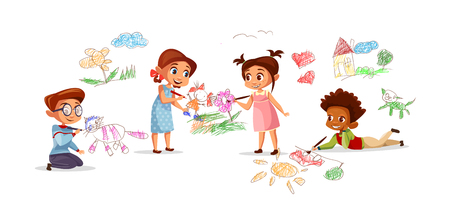1. The Roots of Sibling Rivalry
Sibling rivalry is a common experience in many families, often starting at a young age and continuing into adulthood. While some level of competition between siblings is natural, understanding the underlying causes can help parents manage conflicts and foster stronger relationships. Several psychological and environmental factors contribute to sibling rivalry.
Psychological Factors
Children are constantly seeking attention, validation, and their own sense of identity within the family. These psychological needs can sometimes lead to competition and conflict between siblings.
Common Psychological Causes of Sibling Rivalry
| Factor | Description |
|---|---|
| Need for Parental Attention | Children often compete for their parents’ time, love, and approval. If one child feels neglected or overlooked, it can create resentment toward their sibling. |
| Birth Order Dynamics | The eldest child may feel pressured to be responsible, while younger siblings might struggle to assert independence. These differences can lead to tension. |
| Personality Differences | Siblings with contrasting personalities may clash more frequently, especially if one is naturally dominant while the other is more passive. |
| A Sense of Fairness | If children perceive that rules or privileges are not applied equally among siblings, they may develop feelings of jealousy or frustration. |
Environmental Factors
The family environment plays a crucial role in shaping sibling relationships. External influences such as parenting style and household dynamics can either intensify rivalry or promote harmony.
The Role of Parenting in Sibling Rivalry
- Parental Comparisons: When parents compare siblings—whether academically, athletically, or behaviorally—it can create feelings of inadequacy and increase rivalry.
- Differing Expectations: If parents have different expectations for each child based on gender, abilities, or interests, it can lead to resentment.
- Lack of Conflict Resolution Skills: Without guidance on how to resolve disagreements constructively, siblings may resort to arguing or competing rather than communicating effectively.
The Influence of External Environments
Siblings do not grow up in isolation; factors outside the home also shape their interactions. School pressures, friendships, and social comparisons can all impact how siblings relate to each other.
- Ages and Developmental Stages: Younger children may struggle with sharing toys, while teenagers might argue over personal space or independence.
- Cultural Norms: In some cultures, there is a strong emphasis on sibling responsibility and hierarchy, which can influence rivalry dynamics.
- The Presence of Stressors: Family financial struggles, moving homes, or parental divorce can increase tension between siblings as they navigate changes together.
Nurturing Positive Sibling Relationships
Sibling rivalry is a normal part of growing up, but understanding its root causes allows parents to create an environment where competition does not turn into long-term resentment. Encouraging open communication, fostering teamwork instead of competition, and ensuring each child feels valued can make a significant difference in shaping healthy sibling bonds.
2. The Role of Parenting in Shaping Sibling Dynamics
Parenting plays a crucial role in shaping how siblings interact with one another. The way parents discipline, show affection, and resolve conflicts can either strengthen the bond between siblings or create tension and rivalry. Understanding the impact of parenting styles, favoritism, and conflict resolution strategies can help foster a more harmonious sibling relationship.
How Parenting Styles Influence Sibling Relationships
Different parenting styles affect sibling dynamics in various ways. Some approaches encourage cooperation and mutual respect, while others may unintentionally create competition or resentment.
| Parenting Style | Impact on Sibling Relationships |
|---|---|
| Authoritative | Encourages open communication, fairness, and mutual respect, leading to stronger sibling bonds. |
| Authoritarian | Strict rules and high expectations may lead to sibling rivalry due to pressure and comparison. |
| Permissive | Lack of structure may cause conflicts over boundaries and fairness between siblings. |
| Uninvolved | Siblings may struggle with emotional connection and develop independent rather than cooperative relationships. |
The Impact of Favoritism on Sibling Bonds
If children perceive that their parents favor one sibling over another, it can lead to feelings of jealousy, resentment, and competition. Even unintentional favoritism—such as spending more time with one child due to shared interests—can affect the sibling dynamic. Parents can avoid favoritism by ensuring equal attention, celebrating each childs unique qualities, and fostering a sense of fairness in the household.
Effective Conflict Resolution Strategies
Siblings are bound to have disagreements, but how parents handle these conflicts can shape their long-term relationship. Teaching children healthy ways to manage disputes can reduce resentment and promote teamwork.
Encouraging Open Communication
Create an environment where siblings feel safe expressing their feelings. Encourage them to talk about their frustrations instead of resorting to arguments or physical fights.
Mediating Fairly Without Taking Sides
Avoid automatically siding with one child over the other. Instead, listen to both perspectives and guide them toward a resolution that feels fair for both parties.
Teaching Problem-Solving Skills
Help siblings brainstorm solutions to their conflicts rather than simply punishing them for arguing. This empowers them to handle future disagreements independently.
Praising Positive Interactions
Acknowledge when siblings work together, share, or support one another. Reinforcing positive behavior encourages more harmonious interactions over time.
The way parents approach discipline, favoritism, and conflict resolution has a lasting effect on sibling relationships. By fostering a supportive and fair family environment, parents can help build a strong foundation for lifelong sibling friendship rather than rivalry.

3. From Competition to Cooperation
Sibling rivalry is a natural part of growing up, but with the right guidance, it can transform into a strong and supportive bond. Instead of constant competition, siblings can learn to work together, respect each other’s differences, and build lifelong friendships. Here are some techniques and strategies to help foster cooperation between siblings.
Encouraging Teamwork Over Competition
One effective way to shift from rivalry to friendship is by encouraging teamwork. When siblings see themselves as part of the same team rather than competitors, they are more likely to support each other. Parents can facilitate this by providing opportunities for cooperative activities.
Examples of Cooperative Activities
| Activity | How It Helps |
|---|---|
| Building a Puzzle Together | Encourages patience and problem-solving as a team. |
| Baking or Cooking Together | Teaches cooperation and shared responsibilities. |
| Playing Co-op Video Games | Promotes teamwork and shared victories. |
| Caring for a Pet | Develops responsibility and mutual trust. |
Praising Positive Interactions
Acknowledging and reinforcing positive sibling interactions helps encourage more of them. Instead of focusing only on conflicts, parents should highlight moments when siblings show kindness, cooperation, or support for one another.
Tips for Encouraging Positive Behavior
- Catch them being good: Praise moments when siblings share or help each other.
- Create a reward system: Recognize teamwork with small rewards or privileges.
- Avoid comparisons: Focus on individual strengths instead of comparing achievements.
- Use “we” language: Emphasize family unity by saying things like “We take care of each other.”
Mediating Conflicts Constructively
Siblings will inevitably have disagreements, but teaching them how to resolve conflicts in a healthy way is essential for long-term harmony. Instead of taking sides, parents should guide their children through conflict resolution techniques.
The “Talk-It-Out” Method
- Take a break: Allow siblings to calm down before discussing the issue.
- Let each person speak: Encourage both sides to express their feelings without interruption.
- Find common ground: Help them identify shared interests or solutions that benefit both.
- Create an action plan: Guide them toward a compromise they both agree on.
- Praise their efforts: Acknowledge when they successfully resolve issues together.
Nurturing Mutual Respect and Understanding
Siblings don’t have to be alike to get along. Teaching children to appreciate each other’s differences fosters respect and strengthens their bond over time.
Simplifying Differences Through Perspective-Taking
- “Walk in Their Shoes”: Ask children how they would feel if they were in their sibling’s situation.
- “Strength Finder”: Have each sibling name something they admire about the other.
- “Personal Space Rules”: Teach boundaries by setting clear guidelines for privacy and belongings.
- “Family Meetings”: Create regular check-ins where everyone shares thoughts openly and respectfully.
Sibling relationships evolve over time, and with patience and guidance, rivalry can give way to deep-rooted friendship. By fostering cooperation, teaching conflict resolution skills, and promoting mutual respect, parents can help siblings grow into lifelong allies rather than lifelong rivals.
4. The Lifelong Bond: Sibling Relationships into Adulthood
As siblings grow older, their relationships continue to evolve. Childhood rivalries may fade, replaced by deeper understanding and friendship. However, the impact of early sibling dynamics often lingers, influencing emotional well-being well into adulthood.
How Sibling Relationships Change Over Time
The bond between siblings is constantly changing based on life stages and experiences. Here’s how sibling relationships typically evolve:
| Life Stage | Common Sibling Dynamics |
|---|---|
| Childhood | Frequent rivalry, competition for attention, and shared play experiences. |
| Adolescence | Increased independence, occasional conflicts, but also moments of deep bonding. |
| Young Adulthood | Navigating different life paths, supporting each other through major milestones like college or career choices. |
| Middle Adulthood | A stronger bond often forms as siblings reflect on shared history and support one another emotionally. |
| Later Life | Siblings become sources of comfort and companionship, especially in times of loss or major life transitions. |
The Lasting Impact on Emotional Well-Being
Siblings can have a significant influence on emotional health. Strong sibling bonds often provide lifelong emotional support, helping individuals navigate challenges such as job stress, family responsibilities, and personal setbacks. On the other hand, unresolved childhood rivalries can lead to strained relationships and emotional distress in adulthood.
The Benefits of a Healthy Sibling Relationship
- Emotional Support: A close sibling relationship can act as a safety net during difficult times.
- A Sense of Belonging: Shared history fosters a unique connection that no other relationship can replicate.
- Mental Health Benefits: Positive sibling interactions contribute to lower stress levels and higher overall happiness.
- Lifelong Companionship: As life changes, siblings remain one of the few constants in a person’s life.
Nurturing a Strong Bond as Adults
If sibling relationships were challenging in childhood, it’s never too late to rebuild them. Open communication, shared experiences, and mutual respect can help strengthen connections over time. Investing in a healthy sibling relationship can lead to long-term emotional benefits for both parties.
5. Cultural and Social Influences on Sibling Relationships
Sibling relationships are not just shaped by personal experiences but also by the cultural and social environment in which children grow up. Family values, societal norms, and cultural expectations all play a significant role in how siblings interact with each other. Understanding these influences can help parents foster healthier sibling bonds.
Family Values and Their Impact
Every family has its own set of values that influence sibling dynamics. Some families emphasize cooperation and mutual support, while others encourage independence and competition. These values shape how siblings resolve conflicts, share responsibilities, and express affection.
Common Family Value Systems
| Family Value | Effect on Sibling Relationships |
|---|---|
| Cooperation & Support | Siblings tend to help each other, share responsibilities, and build strong emotional bonds. |
| Independence & Self-Sufficiency | Siblings may be more competitive but also develop strong individual identities. |
| Strict Hierarchical Roles | Elder siblings may take on leadership roles, while younger ones follow set expectations. |
| Open Communication & Emotional Expression | Siblings are more likely to talk through their problems and maintain close relationships into adulthood. |
The Role of Societal Norms
The broader society also shapes how siblings interact. In some cultures, sibling rivalry is seen as a normal part of growing up, while in others, harmony between siblings is strongly encouraged. Social expectations regarding gender roles, birth order, and family responsibilities all contribute to the way siblings relate to one another.
Cultural Differences in Sibling Dynamics
Certain cultures place a strong emphasis on elder siblings taking care of younger ones, while others encourage more equal relationships. For example:
- Western Cultures: Independence is often encouraged, leading to friendly competition but also individual growth.
- Asian Cultures: Respect for elders is emphasized, with older siblings often taking on caregiving roles.
- Mediterranean & Latin American Cultures: Strong family ties mean siblings are expected to remain close throughout life.
The Influence of Media and Peer Groups
The media plays a big role in shaping sibling expectations. TV shows, movies, and books often portray sibling relationships in certain ways—sometimes reinforcing rivalry or highlighting deep friendships. Likewise, peer groups can influence how siblings see themselves in relation to each other.
The Impact of Media Representation
| Stereotype in Media | Plausible Effect on Real-Life Siblings |
|---|---|
| The “Perfect Older Sibling” | Younger siblings might feel pressured to live up to unrealistic standards. |
| The “Troublemaker Younger Sibling” | Might reinforce negative behavior patterns if children internalize the label. |
| “Constant Rivalry” Narrative | Siblings might assume fighting is normal rather than working toward resolution. |
| “Best Friends Forever” Trope | Siblings could feel guilty if their relationship isnt always harmonious. |
Navigating These Influences as Parents
Acknowledging the impact of culture and society can help parents guide their children toward healthier sibling relationships. Encouraging open discussions about family values, exposing kids to positive media representations, and fostering environments where individuality is respected can all contribute to stronger sibling bonds.


